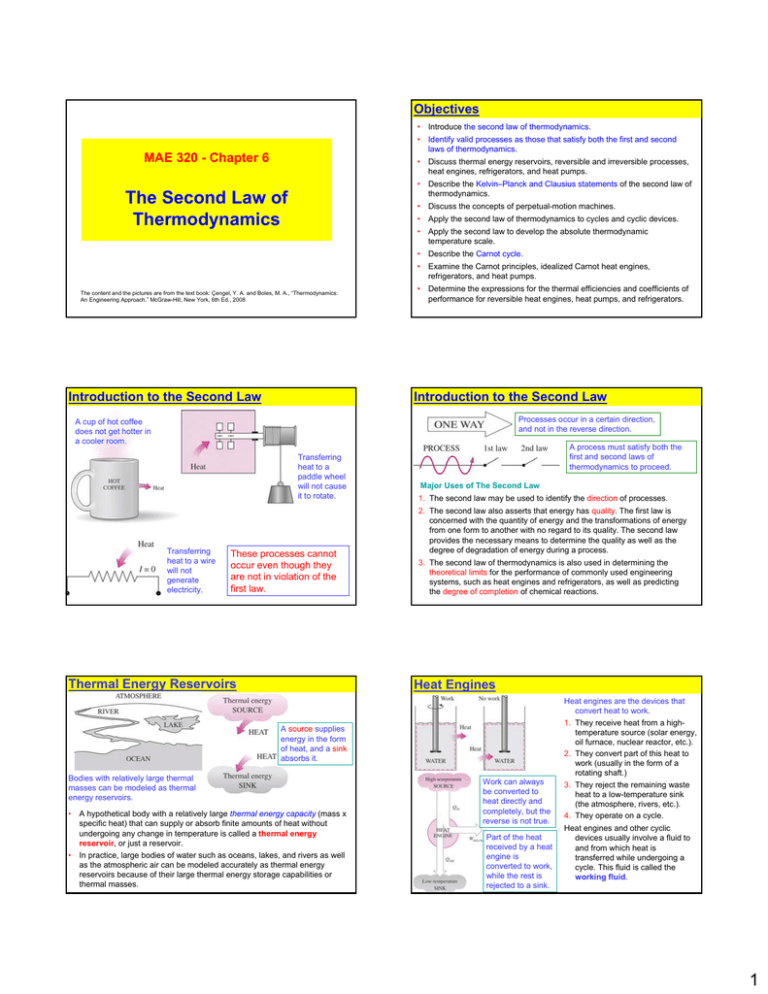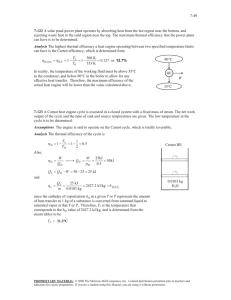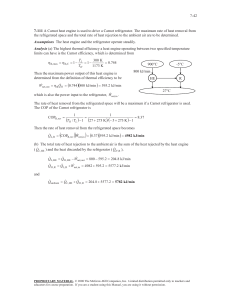PDF The Second Law of Thermodynamics
advertisement

Objectives • Introduce the second law of thermodynamics. • Identify valid processes as those that satisfy both the first and second laws of thermodynamics. MAE 320 - Chapter 6 • Discuss thermal energy reservoirs, reversible and irreversible processes, heat engines, refrigerators, and heat pumps. • Describe the Kelvin–Planck and Clausius statements of the second law of thermodynamics. The Second Law of Thermodynamics • Discuss the concepts of perpetual-motion machines. • Apply the second law of thermodynamics to cycles and cyclic devices. • Apply the second law to develop the absolute thermodynamic temperature scale. • Describe the Carnot cycle. • Examine the Carnot principles, idealized Carnot heat engines, refrigerators, and heat pumps. The content and the pictures are from the text book: Çengel, Y. A. and Boles, M. A., “Thermodynamics: An Engineering Approach,” McGraw-Hill, New York, 6th Ed., 2008 Introduction to the Second Law • Determine the expressions for the thermal efficiencies and coefficients of performance for reversible heat engines, heat pumps, and refrigerators. Introduction to the Second Law Processes occur in a certain direction, and not in the reverse direction. A cup of hot coffee does not get hotter in a cooler room. Transferring heat to a paddle wheel will not cause it to rotate. Transferring heat to a wire will not generate electricity. These processes cannot occur even though they are not in violation of the first law. Thermal Energy Reservoirs A process must satisfy both the first and second laws of thermodynamics to proceed. Major Uses of The Second Law 1. The second law may be used to identify the direction of processes. 2. The second law also asserts that energy has quality. The first law is concerned with the quantity of energy and the transformations of energy from one form to another with no regard to its quality. The second law provides the necessary means to determine the quality as well as the degree of degradation of energy during a process. 3. The second law of thermodynamics is also used in determining the theoretical limits for the performance of commonly used engineering systems, such as heat engines and refrigerators, as well as predicting the degree of completion of chemical reactions. Heat Engines A source supplies energy in the form of heat, and a sink absorbs it. Bodies with relatively large thermal masses can be modeled as thermal energy reservoirs. • A hypothetical body with a relatively large thermal energy capacity (mass x specific heat) that can supply or absorb finite amounts of heat without undergoing any change in temperature is called a thermal energy reservoir, or just a reservoir. • In practice, large bodies of water such as oceans, lakes, and rivers as well as the atmospheric air can be modeled accurately as thermal energy reservoirs because of their large thermal energy storage capabilities or thermal masses. Work can always be converted to heat directly and completely, but the reverse is not true. Part of the heat received by a heat engine is converted to work, while the rest is rejected to a sink. Heat engines are the devices that convert heat to work. 1. They receive heat from a hightemperature source (solar energy, oil furnace, nuclear reactor, etc.). 2. They convert part of this heat to work (usually in the form of a rotating shaft.) 3. They reject the remaining waste heat to a low-temperature sink (the atmosphere, rivers, etc.). 4. They operate on a cycle. Heat engines and other cyclic devices usually involve a fluid to and from which heat is transferred while undergoing a cycle. This fluid is called the working fluid. 1 Thermal efficiency A steam power plant Schematic of a heat engine. A portion of the work output of a heat engine is consumed internally to maintain continuous operation. Even the most efficient heat engines reject almost one-half of the energy they receive as waste heat. Thermal efficiency Some heat engines perform better than others (convert more of the heat they receive to work). Can we save Qout? In a steam power plant, the condenser is the device where large quantities of waste heat is rejected to rivers, lakes, or the atmosphere. Can we not just take the condenser out of the plant and save all that waste energy? The answer is, unfortunately, a firm no for the simple reason that without a heat rejection process in a condenser, the cycle cannot be completed. Can we save Qout? Kelvin–Planck Statement A heat-engine cycle cannot be completed without rejecting some heat to a lowtemperature sink. Kelvin-Planck Statement: It is impossible for any device that operates on a cycle to receive heat from a single reservoir and produce a net amount of work. No heat engine can have a thermal efficiency of 100 percent, or as for a power plant to operate, the working fluid must exchange heat with the environment as well as the furnace. The impossibility of having a 100% efficient heat engine is not due to friction or other dissipative effects. It is a limitation that applies to both the idealized and the actual heat engines. A heat engine that violates the Kelvin–Planck statement of the second law. 2 Refrigerators and Heat Pumps Basic components of a refrigeration system and typical operating conditions. Coefficient of Performance for Refrigerators • The transfer of heat from a low-temperature medium to a high-temperature one requires special devices called refrigerators. • Refrigerators, like heat engines, are cyclic devices. • The working fluid used in the refrigeration cycle is called a refrigerant. • The most frequently used refrigeration cycle is the vapor-compression refrigeration cycle. In a household refrigerator, the freezer compartment where heat is absorbed by the refrigerant serves as the evaporator, and the coils usually behind the refrigerator where heat is dissipated to the kitchen air serve as the condenser. Coefficient of Performance for Heat Pumps The efficiency of a refrigerator is expressed in terms of the coefficient of performance (COP). COPR can be greater than unity. That is, the amount of heat removed from the refrigerated space can be greater than The objective of a refrigerator is to the amount of work input remove QL from the cooled space. Coefficient of Performance for Heat Pumps The objective of a heat pump is to supply heat QH into the warmer space. • Most heat pumps in operation today have a seasonally averaged COP of 2 to 3. • Most existing heat pumps use the cold outside air as the heat source in winter (airsource HP). • Air conditioners are basically refrigerators whose refrigerated space is a room or a building instead of the food compartment. • The COP of a refrigerator decreases with decreasing refrigeration temperature. • Therefore, it is not economical to refrigerate to a lower temperature than needed. for fixed values of QL and QH Can the value of COPHP be lower than unity? What does COPHP=1 represent? Energy efficiency rating (EER): The amount of heat removed from the cooled space in Btu’s for 1 Wh (watthour) of electricity consumed. When installed backward, an air conditioner functions as a heat pump. Coefficient of Performance for Refrigerator Coefficient of Performance for Refrigerator Example 6-3 Example 6-3 (a) The coefficient of performance of the refrigerator: • COP R = QL = • Wnet , in 360 kJ / min 360 kJ / 60 s = =3 2 kW 2 kJ / s (b) The rate of heat ejected to room: • • • Q H = Q L + W net ,in = 360 kJ / min + 2kW = 360kJ /(60 s ) + 2kJ / s = 8kJ / s 3 Clausius Statement Equivalence of Two Statements It is impossible to construct a device that operates in a cycle and produces no effect other than the transfer of heat from a lower-temperature body to a higher-temperature body. The Kelvin–Planck and the Clausius statements are equivalent in their consequences, and either statement can be used as the expression of the second law of thermodynamics. Any device that violates the Kelvin–Planck statement also violates the Clausius statement, and vice versa. It states that a refrigerator cannot operate unless its compressor is driven by an external power source, such as an electric motor. This way, the net effect on the surroundings involves the consumption of some energy in the form of work, in addition to the transfer of heat from a colder body to a warmer one. To date, no experiment has been conducted that contradicts the second law, and this should be taken as sufficient proof of its validity. A refrigerator that violates the Clausius statement of the second law. Perpetual-motion Machines Reversible and Irreversible Processes Reversible process: A process that can be reversed without leaving any trace on the surroundings. Irreversible process: A process that is not reversible. During a cycle, a system can be restored to its initial state following a process, regardless of whether the process is reversible or irreversible. But for reversible processes, this restoration is made without leaving any net change on the surroundings, A perpetual-motion machine that violates the first law (PMM1). A perpetual-motion machine that violates the second law of thermodynamics (PMM2). whereas for irreversible processes, the surroundings usually do some work on the system and therefore does not return to their original state. Perpetual-motion machine: Any device that violates the first or the second law. A device that violates the first law (by creating energy) is called a PMM1. A device that violates the second law is called a PMM2. Two familiar reversible processes. Despite numerous attempts, no perpetual-motion machine is known to have worked. If something sounds too good to be true, it probably is. Reversible and Irreversible Processes Irreversible Processes Friction renders a process irreversible. Reversible processes deliver the most and consume the least work. • • • • • • • All the processes occurring in nature are irreversible. Why are we interested in reversible processes? (1) they are easy to analyze and (2) they serve as idealized models (theoretical limits) to which actual processes can be compared. Some processes are more irreversible than others. We try to approximate reversible processes. • The factors that cause a process to be irreversible are called irreversibilities. They include friction, unrestrained expansion, mixing of two fluids, heat transfer across a finite temperature difference, electric resistance, inelastic deformation of solids, and chemical reactions. The presence of any of these effects renders a process irreversible. (a) Heat transfer through a temperature difference is irreversible, and (b) the reverse process is impossible. 4 Irreversible Processes Internally & Externally Reversible Processes Irreversible compression and expansion processes. • Internally reversible process: If no irreversibilities occur within the boundaries of the system during the process. • Externally reversible: If no irreversibilities occur outside the system boundaries. Totally and internally reversible heat transfer processes. Internally & Externally Reversible Processes The Carnot Cycle • Totally reversible process: It involves no irreversibilities within the system or its surroundings. A totally reversible process involves no heat transfer through a finite temperature difference, no nonquasi-equilibrium changes, and no friction or other dissipative effects. Execution of the Carnot cycle in a closed system. Reversible Isothermal Expansion (process 1-2): TH = constant, Pv = mRT =C; heat input QH Reversible Adiabatic Expansion (process 2-3): temperature drops from TH to TL; Pvn=C A reversible process involves no internal and external irreversibilities. The Carnot Cycle The Carnot Cycle Reversible Isothermal Compression (process 3-4): TL = constant; Pv = mRT = C; heat release QL Wnet, out =QH-QL Pv=C Pvn=C Reversible Adiabatic Compression (process 4-1): temperature rises from TL to TH, Pvn =C P-V diagram of the Carnot cycle. 5 The Carnot Principles The Reversed Carnot Cycle The Carnot principles Wnet, in =QH-QL • The efficiency of an irreversible heat engine is always less than the efficiency of a reversible one operating between the same two reservoirs. L QL (1) –(2) Pv=C (2) –(3) Pvn=C QH H • The efficiencies of all reversible heat engines operating between the same two reservoirs are the same. (3) –(4) (4) –(1) P-V diagram of the reversed Carnot cycle. The Carnot heat-engine cycle is a totally reversible cycle. Therefore, all the processes that comprise it can be reversed, in which case it becomes the Carnot refrigeration cycle. The Thermodynamic Temperature Scale The Carnot Principles R Proof of the first Carnot principle. The Thermodynamic Temperature Scale All reversible heat engines operating between the same two reservoirs have the same efficiency. The efficiency of reversible engines is independent of the working fluid and its property The arrangement of heat engines used to develop the thermodynamic temperature scale. The Thermodynamic Temperature Scale Since the energy of reservoirs is characterized by the temperature, the thermal efficiency if reversible heat engines is a function of the reservoir temperature only: ηth,rev = Wnet,out Q H −QL Q = = 1 − L = g (TH , TL ) QH QH QH For all the engines in the figure For a reversible heat engine between two reservoirs at temperature TH and TL Lord Kelvin has proposed taking temperature as to define the thermodynamic The temperature scale is called the Kelvin scale. The temperature on this scale is called absolute temperature. A temperature scale that is independent of the properties of the substances that are used to measure temperature is called a thermodynamic temperature scale. Left side is not a function of T2, the condition will be met if the right side will be: Such a temperature scale offers great conveniences in thermodynamic calculations. 6 The Thermodynamic Temperature Scale The Carnot Heat Engine Any heat engine absolute temperatures. Carnot heat engine -- Carnot efficiency For reversible cycles, the heat transfer ratio QH /QL can be replaced by the absolute temperature ratio TH /TL. A conceptual experimental setup to determine thermodynamic temperatures on the Kelvin scale by measuring heat transfers QH and QL. The Carnot Heat Engine The Carnot Heat Engine The Carnot heat engine is the most efficient of all heat engines operating between the same high- and lowtemperature reservoirs. No heat engine can have a higher efficiency than a reversible heat engine operating between the same high- and low-temperature reservoirs. The Carnot Heat Engine The Quality of Energy Example 6-5 Can we use °C unit for temperature here? The higher the temperature of the thermal energy, the higher its quality. The fraction of heat that can be converted to work as a function of source temperature. How do you increase the thermal efficiency of a Carnot heat engine? How about for actual heat engines? 7 The Carnot Refrigerator and Heat Pump Any refrigerator or heat pump The Carnot Refrigerator and Heat Pump Example 6-7 A heat pump is used to heat a house during the winter as shown in Fig. 6-53. The house is maintained at 21 oC at all times. The house is estimated to be losing heat at a rate of 135 MJ/h when the outside temperature drop to – 5 oC. Determined the minimum power required to drive this heat pump. Carnot refrigerator or heat pump No refrigerator can have a higher COP than a reversible refrigerator operating between the same temperature limits. How do you increase the COP of a Carnot refrigerator or heat pump? How about for actual ones? The Carnot Refrigerator and Heat Pump Summary Example 6-7 • Introduction to the second law • Heat engines 9 Thermal efficiency 9 The 2nd law: Kelvin-Planck statement • Refrigerators and heat pumps 9 Coefficient of performance (COP) 9 The 2nd law: Clasius statement • Perpetual motion machines • Reversible and irreversible processes 9 Irreversibilities, Internally and externally reversible processes • The Carnot cycle 9 The reversed Carnot cycle • The Carnot principles • The thermodynamic temperature scale • The Carnot heat engine 9 The quality of energy • The Carnot refrigerator and heat pump 8




